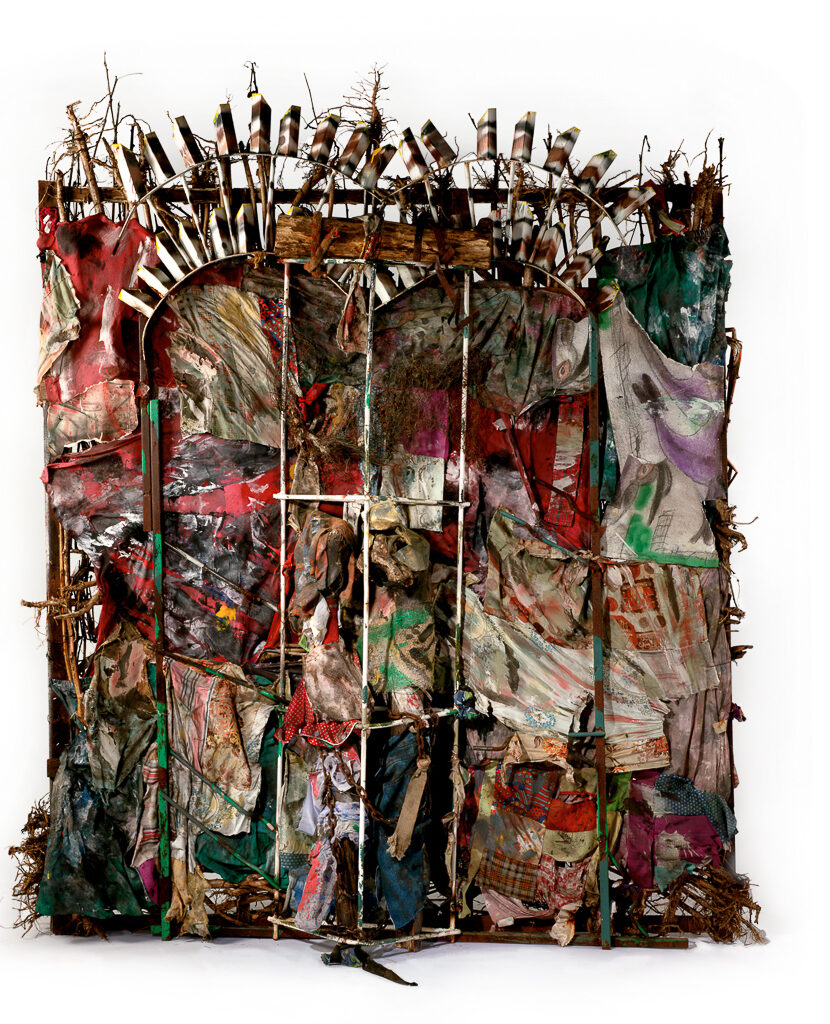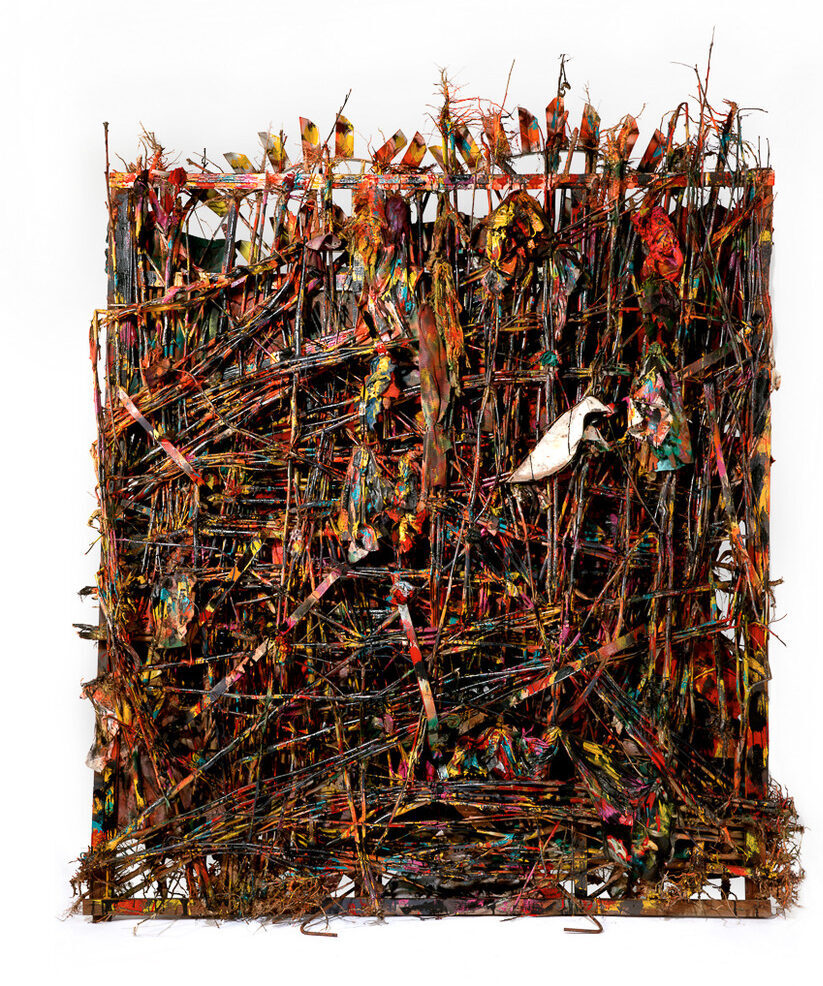Thornton Dial's History Refused to Die
Thornton Dial’s (1928-2016) large, assembled sculpture History Refused to Die (2004) is a confrontational piece about Dial’s connection between objects of labor and creative agency. The work was a highlight among the fifty-seven works made by Black self-taught artists whose work was gifted to the Metropolitan Museum of Art in 2014, and the accompanying exhibition in 2018 used the exact title. Contrary to its monumental size and prominent exhibition display, existing scholarships have not given History Refused to Die critical attention. This capstone deciphers how the artist embeds his personal journey in this monumental work by navigating through the various objects Dial used, which draw on spheres of labor, including agriculture, heavy industry, and domestic labor. Moreover, History Refused to Die simultaneously draws attention to other communities he was familiar with, such as the Gee’s Bend quilters and Black vernacular yard artists, specifically Mary Lee Bendolph (1935-) and Lonnie Holly (1950-), respectively (Fig 2). This capstone also investigates Dial’s deep engagement with the idea of labor, which is evident through his interview transcripts that pertain to his upbring in Alabama and his close relationship with Black Southern artist communities.
Currently, Thornton Dial’s History Refused to Die is stored in a private facility away from the public view. In the work’s complete form, it stands eight feet tall and seven feet wide, towering over the viewer. As the spectator moves around the work, they are exposed to a clustered nest of materials on two very distinct sides. On one side, the work is comprised of shredded heaps of clothing, quilts, ripped burlap, wire, wood, paint, okra roots and stalks, and various tattered pieces of shop rags: a clustered nest of materials on two sides brought together through welding, bending, twisting, and painting, and tying (Fig. 1: left image). Towards the bottom right, one side shows a seemingly piece-by-piece display of quilts showing their intricate details with either plaid or dotted patterns. Strips of painted, ripped shop rags, abstracted watercolor drawings, and burlap deceptively connect in and around the quilts to mimic a similar square-shaped form and are neatly confined in a metal gate with a sharp, tapered top. Older, stained fabrics work together to form a sense of unity, and they are reinforced by a sharp metal gate and a steel chain. Metal wire pieces and rods press and bend around as a colorful shield of the fabrics. The reverse side of the work presents a layered nest of objects that are difficult to comb through (Fig. 1: right image). Resting on the surface of the lattice-like wall of wire, wood, paint, and tattered pieces of clothing and rags is Dial’s signature tin bird motif: a figure that has represented freedom and flight across his sculptures.
Figure 1: [left front side, right: back side] Thornton Dial, History Refused to Die, 2004. Okra stalks and roots, clothing, collaged drawings, tin, wire, steel, Masonite, steel chain, enamel, and spray paint, 102 x 87 x 23 inches, Metropolitan Museum of Art. Image: Stephen Pitkin, Pitkin Studio, Souls Grown Deep Foundation.
Objects unify both sides of the work but also show distinct differences. Shown on one side are objects that readily identify as once usable items, while on the other side, objects appear nearly blended and painted over with bold, layered colors. Some of them, such as steel, iron, wood, shop rags, and clothing pieces, were all readily available around Dial’s home and in his workshop. He determined for himself which objects conveyed multiple ideas and concepts about his experiences navigating his environment. Dial only used materials that were found or that had been gifted to him because they had already fulfilled their purpose either by himself or somebody else. For example, the collector William Arnett purchased much of his work and supplied Dial with plywood material that the artist often used as the main backboard for his freestanding sculptures.[1] Considering Dial’s strong preference for discarded utilitarian materials for History Refused to Die, it is necessary to investigate the spaces where such objects likely existed to arrive at a possible meaning for the work as a whole.
History Refused to Die is a striking work of art—each side visualizes Dial’s autobiographical journey as a working individual who developed strong social connections with other artists. The woven materials, as well as the work’s title, draw attention to a shared, challenging labor experienced by Black Americans in the South that references a history of slavery and poverty. Dial explored these topics whilst living through generational poverty and a racially divided work life, and scholars have researched this aspect of his work in depth. However, rather than solely focusing on the theme of struggle and the racial disparities that affected the artist, I articulate the responses that he made with his materials. As the title of the work suggests, Dial engages with the act of refusal suggesting that his objects manifest this idea and a history of endurance. Considering Dial’s title, I analyze History Refused to Die with a framework that focuses on his occupational history and artists’ peers. Dial’s History Refused to Die recounts his time spent farming in plantation fields, utilizing steel in metal workshops, and his investment in the stitching quilting process used in the Gee’s Bend community.
By drawing on Dial’s biography, and his experiences working in agriculture, heavy industry, and meeting the Gee’s Bend quilters, I aim to detail the impact of these experiences on the meaning of the artist’s work. I also propose that History Refused to Die borrows from traditions of Black vernacular yard art, a cultural practice that involves the public adornment of art consisting of everyday objects.[2] The work combines the communicative power of discarded objects that were used in spaces where Dial devoted years of his life conducting manual labor and his handling of material was a response that grew from his astute observations of others who utilize objects for personal, creative purposes, or production purposes.
Acknowledgements
I would like to thank all of the individuals who have helped make this master’s capstone project a reality. Without your help, I would not have the knowledge that ultimately shaped my project and become what it is today.
First, I would like to thank my readers, Dr. Ying-chen Peng and Dr. Nika Elder for their efforts in making my project appear cohesive and strong. I would also like to thank Dr. Andrew Wasserman, who advised me with my capstone structure and pushed me to keep moving forward with my project. I additionally want to thank Dr. Joanne Allen for her valuable insights on website design and creation and for providing your feedback on my capstone.
Thank you also to my graduate cohort, who brought their wisdom, encouragement, humor, and a sense of relatability when discussing our individual capstone projects.
I am also endlessly grateful for my parents, who spent time listening to me and offering their feedback on my project. Thank you for believing in me and my capstone project.
MA Capstone
Master’s Capstone Project submitted to the Faculty of the College of Arts and Sciences of American University in Partial Fulfillment of the Requirements for the Degree of Master’s of Arts in Art History.
Chair: Dr. Ying-Chen Peng; Readers: Dr. Nika Elder and Dr. Andrew Wasserman.
December 15th, 2024. American University, Washington DC.
Fair Use
This website, consisting of the capstone project by Juhianna Boeye for her Master’s in Art History at American University (Washington, D.C.), may contain copyrighted material, the use of which many not have been specifically authorized by the copyright owner. The material contained in this website is distributed without profit for research and educational purposes. This should constitute a ‘fair use’ of any such copyrighted material (referenced and provided for in section 107 of the US Copyright Law). If you wish to use any copyrighted material from this site for purposes of your own that go beyond ‘fair use,’ you must obtain expressed permission from the copyright owner.
Fair Use
Copyright Disclaimer under section 107 of the Copyright Act of 1976, allowance is made for ‘fair use’ for purposes such as criticism, comment, news reporting, teaching, scholarship, education, research. Fair use is a sue permitted by copyright statue that might otherwise be infringing.
Fair Use Definition
Fair use is a doctrine in the United States copyright law that allows limited use of copyrighted material without requiring permission from the rights holders, such as commentary, criticism, news reporting, research, teaching, or scholarship. It provides for the legal, non-licensed citation or incorporation of copyrighted material in another author’s work under a four-factor balancing test.
How to Cite
Boeye, Juhianna. “Thornton Dial’s History Refused to Die.” MA Thesis, American University, 2024.
[1] “Thornton Dial,” Souls Grown Deep Foundation. https://www.soulsgrowndeep.org/artist/thornton-dial.
[2] Aleesa Pitchamarn Alexander, “Magic City Modern: A Short History of the Birmingham-Bessemer School,” Panorama: Journal of the Association of Historians of American Art 6, no. 1 (Spring 2020): 4, https://doi.org/10.24926/24716839.9831.


